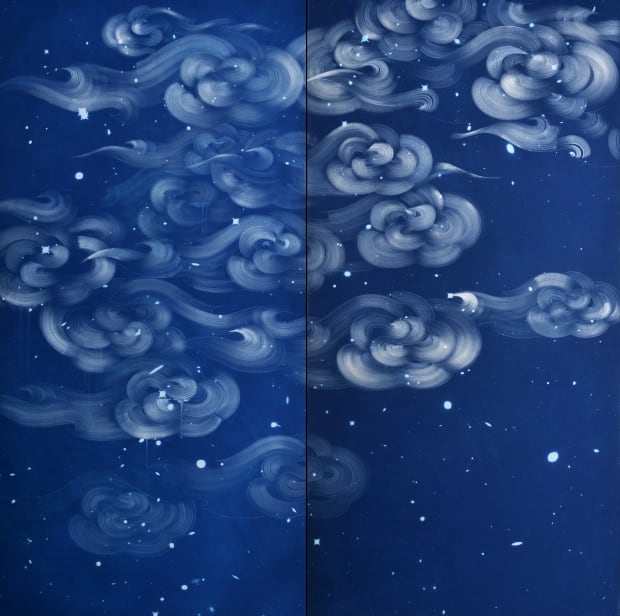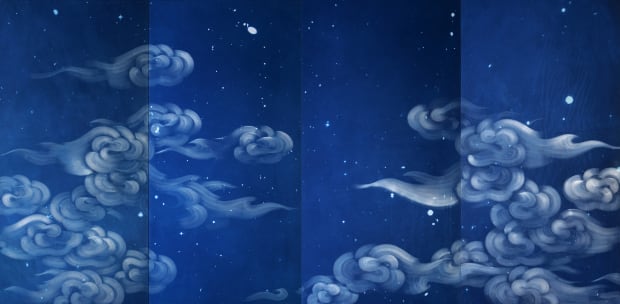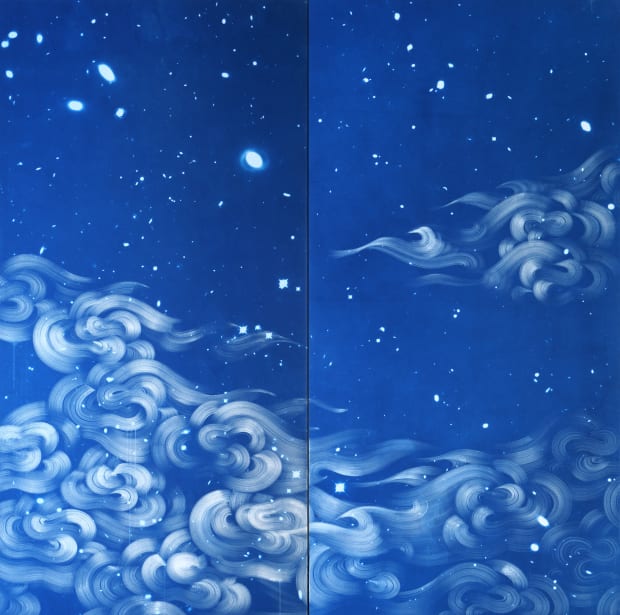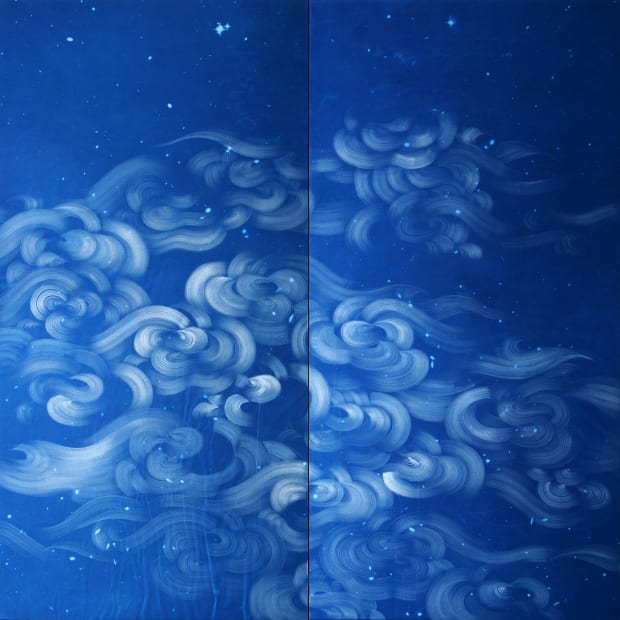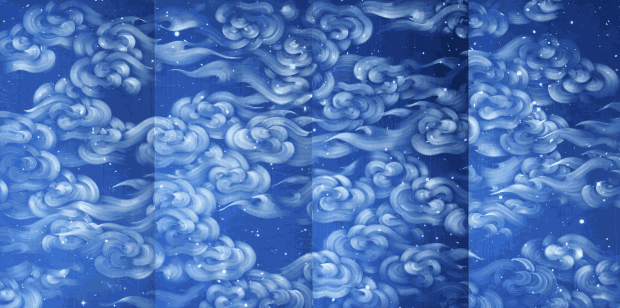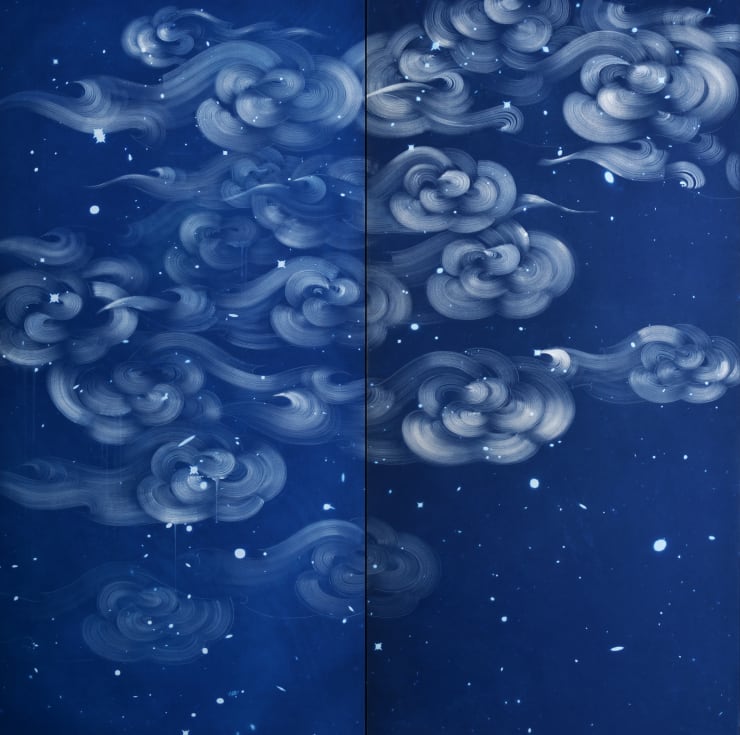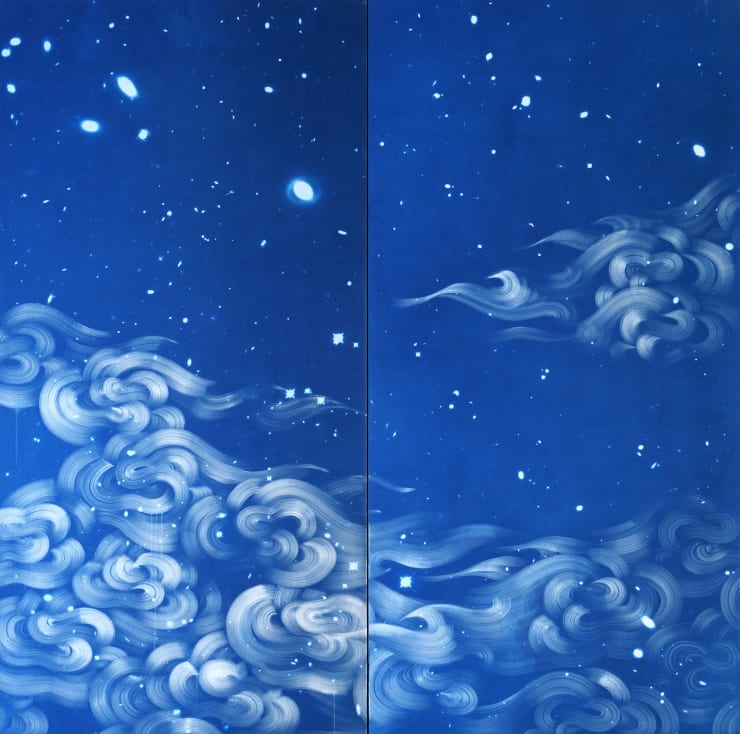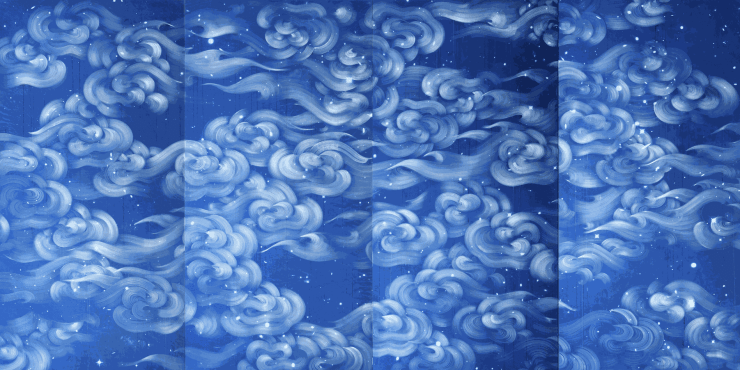-
Ala Ebtekar
The Sky of the Seven Valleys
-
Zenith 2024
Elizabeth Rauh -
 Ala Ebtekar, Zenith I, 2023 - 2024, Acrylic and charcoal underdrawing on cyanotype on canvas exposed by sun, moon, and starlight,182.88 x 182.88 x 5.08 cm, Diptych
Ala Ebtekar, Zenith I, 2023 - 2024, Acrylic and charcoal underdrawing on cyanotype on canvas exposed by sun, moon, and starlight,182.88 x 182.88 x 5.08 cm, Diptych -
-
 Ala Ebtekar, Zenith II, 2023 - 2024,Acrylic and charcoal underdrawing on cyanotype on canvas exposed by sun, moon, and starlight, 182.88 x 365.76 x 5.08 cm, Quadriptych
Ala Ebtekar, Zenith II, 2023 - 2024,Acrylic and charcoal underdrawing on cyanotype on canvas exposed by sun, moon, and starlight, 182.88 x 365.76 x 5.08 cm, Quadriptych -
-
 Ala Ebtekar, Zenith III, 2023 - 2024, Acrylic and charcoal underdrawing on cyanotype on canvas exposed by sun, moon, and starlight,182.88 x 365.76 x 5.08 cm, Quadriptych
Ala Ebtekar, Zenith III, 2023 - 2024, Acrylic and charcoal underdrawing on cyanotype on canvas exposed by sun, moon, and starlight,182.88 x 365.76 x 5.08 cm, Quadriptych -
-
 Ala Ebtekar, Zenith IV, 2023 - 2024, Acrylic and charcoal underdrawing on cyanotype on canvas exposed by sun, moon, and starlight, 182.88 x 182.88 x 5.08 cm, Diptych
Ala Ebtekar, Zenith IV, 2023 - 2024, Acrylic and charcoal underdrawing on cyanotype on canvas exposed by sun, moon, and starlight, 182.88 x 182.88 x 5.08 cm, Diptych -
 Ala Ebtekar,Zenith V, 2023 - 2023, Acrylic and charcoal underdrawing on cyanotype on canvas exposed by sun, moon, and starlight, 182.88 x 182.88 x 5.08 cm
Ala Ebtekar,Zenith V, 2023 - 2023, Acrylic and charcoal underdrawing on cyanotype on canvas exposed by sun, moon, and starlight, 182.88 x 182.88 x 5.08 cm -
-
 Ala Ebtekar, Zenith VI, 2023 - 2024, Acrylic and charcoal underdrawing on cyanotype on canvas exposed by sun, moon, and starlight, 182.88 x 365.76 x 5.08 cm
Ala Ebtekar, Zenith VI, 2023 - 2024, Acrylic and charcoal underdrawing on cyanotype on canvas exposed by sun, moon, and starlight, 182.88 x 365.76 x 5.08 cm -
-
 Ala EbtekarZenith I, 2023 - 2024Acrylic and charcoal underdrawing on cyanotype on canvas exposed by sun, moon, and starlight182.88 x 182.88 x 5.08 cm, Diptych
Ala EbtekarZenith I, 2023 - 2024Acrylic and charcoal underdrawing on cyanotype on canvas exposed by sun, moon, and starlight182.88 x 182.88 x 5.08 cm, Diptych -
 Ala EbtekarZenith II, 2023 - 2024Acrylic and charcoal underdrawing on cyanotype on canvas exposed by sun, moon, and starlight182.88 x 365.76 x 5.08 cm, Quadriptych
Ala EbtekarZenith II, 2023 - 2024Acrylic and charcoal underdrawing on cyanotype on canvas exposed by sun, moon, and starlight182.88 x 365.76 x 5.08 cm, Quadriptych -
 Ala EbtekarZenith III, 2023 - 2024Acrylic and charcoal underdrawing on cyanotype on canvas exposed by sun, moon, and starlight182.88 x 365.76 x 5.08 cm, Quadriptych
Ala EbtekarZenith III, 2023 - 2024Acrylic and charcoal underdrawing on cyanotype on canvas exposed by sun, moon, and starlight182.88 x 365.76 x 5.08 cm, Quadriptych -
 Ala EbtekarZenith IV, 2023 - 2024Acrylic and charcoal underdrawing on cyanotype on canvas exposed by sun, moon, and starlight182.88 x 182.88 x 5.08 cm, Diptych
Ala EbtekarZenith IV, 2023 - 2024Acrylic and charcoal underdrawing on cyanotype on canvas exposed by sun, moon, and starlight182.88 x 182.88 x 5.08 cm, Diptych -
 Ala EbtekarZenith V, 2023 - 2024Acrylic and charcoal underdrawing on cyanotype on canvas exposed by sun, moon, and starlight182.88 x 182.88 x 5.08 cm, Diptych
Ala EbtekarZenith V, 2023 - 2024Acrylic and charcoal underdrawing on cyanotype on canvas exposed by sun, moon, and starlight182.88 x 182.88 x 5.08 cm, Diptych -
 Ala EbtekarZenith VI, 2023 - 2024Acrylic and charcoal underdrawing on cyanotype on canvas exposed by sun, moon, and starlight182.88 x 365.76 x 5.08 cm, Quadriptych
Ala EbtekarZenith VI, 2023 - 2024Acrylic and charcoal underdrawing on cyanotype on canvas exposed by sun, moon, and starlight182.88 x 365.76 x 5.08 cm, Quadriptych -
 Ala EbtekarZenith VII, 2023 - 2024Acrylic and charcoal underdrawing on cyanotype on canvas exposed by sun, moon, and starlight182.88 x 91.44 x 5.08 cm
Ala EbtekarZenith VII, 2023 - 2024Acrylic and charcoal underdrawing on cyanotype on canvas exposed by sun, moon, and starlight182.88 x 91.44 x 5.08 cm
-
-
About Ala Ebtekar
Ala Ebtekar (b. 1978 Berkeley, CA) is an artist who, for over two decades, has situated his practice as a relentless leveling and collapsing of time and space to bring steadying attention to the contemporary moment.
His work frequently orchestrates various orbits and cadences of time, bringing forth sculptural and photographicpossibilities of the universe, and time, gazing back at us. This extensive research and making process borrows andphysically reworks thousand year old image/object-making traditions up to the latest technological advances in production.
Ebtekar’s recent investigations have created liminal experiences to longer notions of scientific duration beyond human timelines, in particular cosmic travel & the phenomenology of light. Considering light itself as both concept, medium,and even the possibilities of light as healing he uses a range of radiation in his practice, such as works birthed by daytime uv-light emitted from the sun, or night exposures that were produced by moonlight and starlight. With this method, his recent photographic works take a whole night to expose, continuing durational projects and works which he views as in collaboration with the sun and stars.
Ebtekar’s works are in public and private collections including the British Museum, London, UK, Whitney Museum of American Art, New York, USA; Devi Art Foundation, Delhi, India; Orange County Museum of Art, CA, USA; Deutsche Bank, Frankfurt, Germany; de Young Fine Arts Museum, San Francisco, USA; Crocker Art Museum, CA,USA; Microsoft Art Collection, Redmond, WA, USA; Berkeley Art Museum, CA, USA; UCSF Medical Center, CA,USA, among others.
-
About Elizabeth Rauh
Elizabeth Rauh is an assistant professor of Modern Art History and Visual Cultures at The American University in Cairo (AUC). Specializing in the history of arts and visual cultures of Iraq, Iran, and the Persian Gulf, her work examines artist engagements with Islamic heritage, popular image practices and technologies in the Islamic world, and arts of the twentieth-century "Shi`i Left." She also pursues research in ecological art practices in the Gulf, such as in her article “Experiments in Eden: Midcentury Artist Voyages into the Mesopotamian Marshlands” (Journal of Contemporary Iraq and the Arab World, 2021). Her research has been funded by The Academic Research Institute in Iraq, the Darat al Funun Center for Modern and Contemporary Arab Art, the Max Weber Foundation, and the Andrew W. Mellon Foundation.
Ala Ebtekar : The Sky of the Seven Valleys
Past viewing_room

